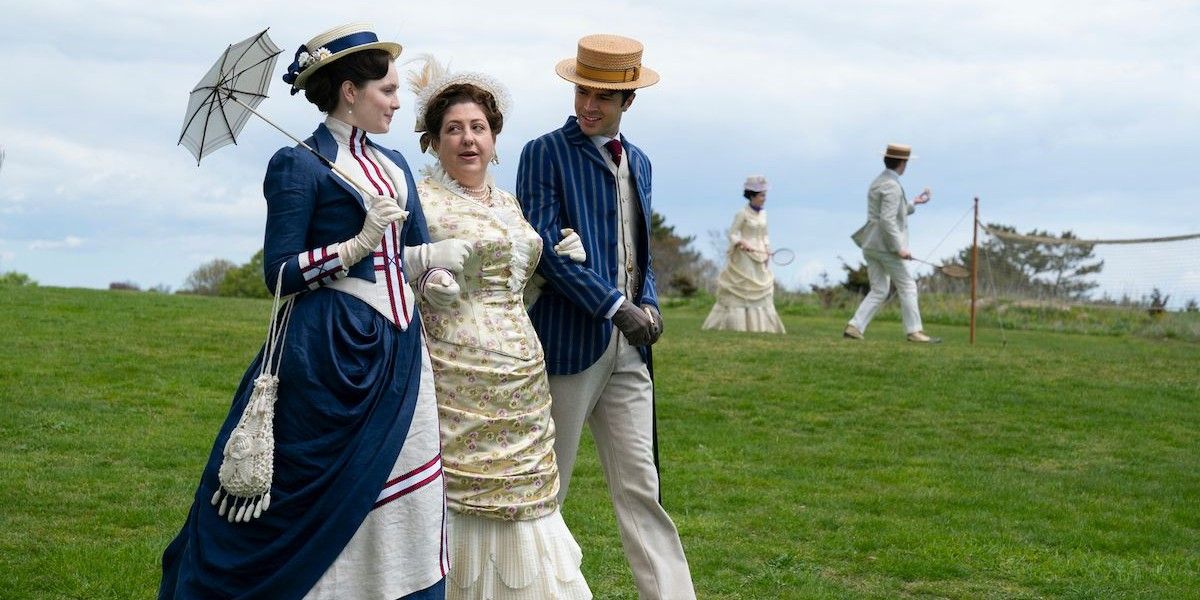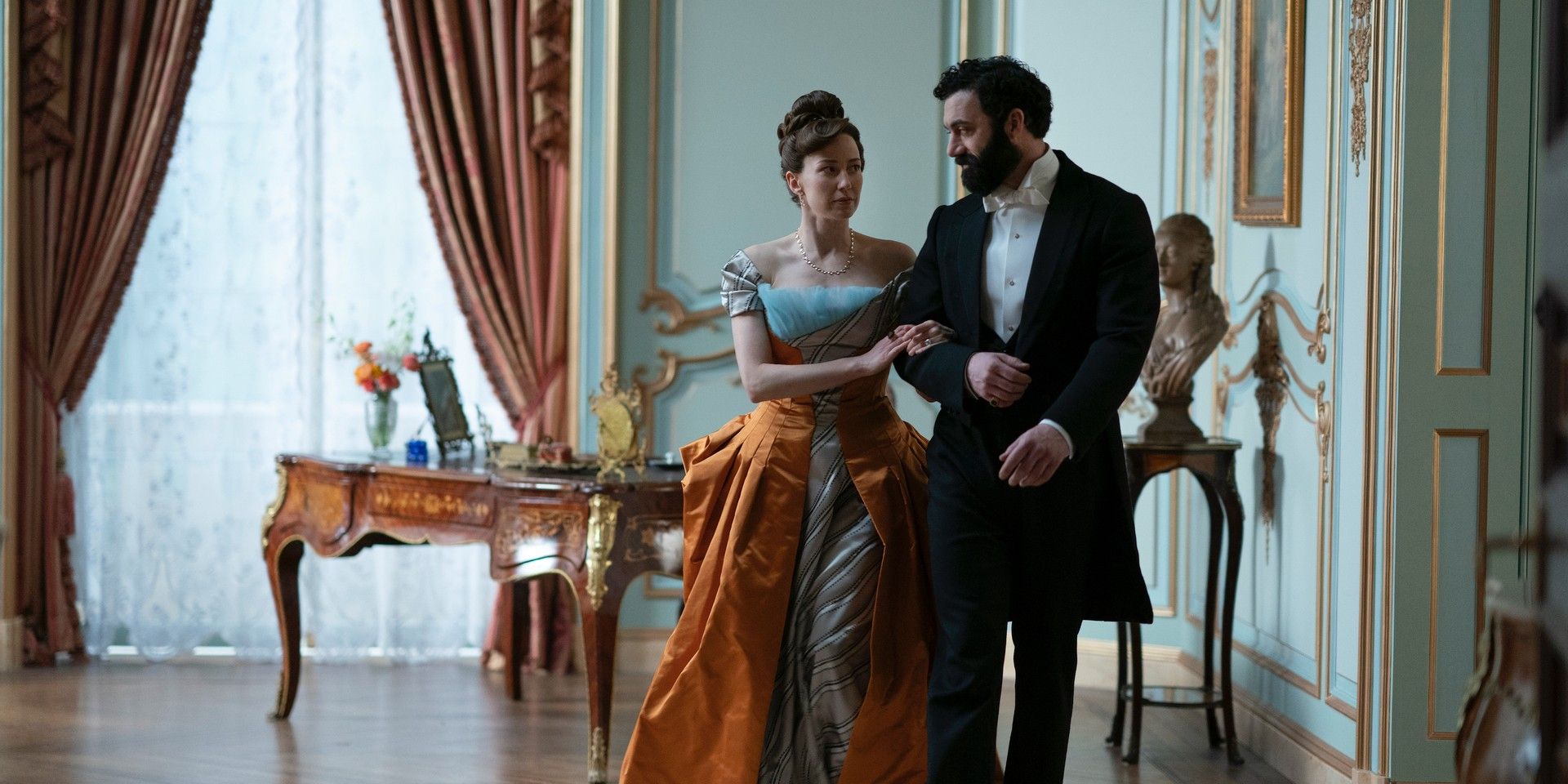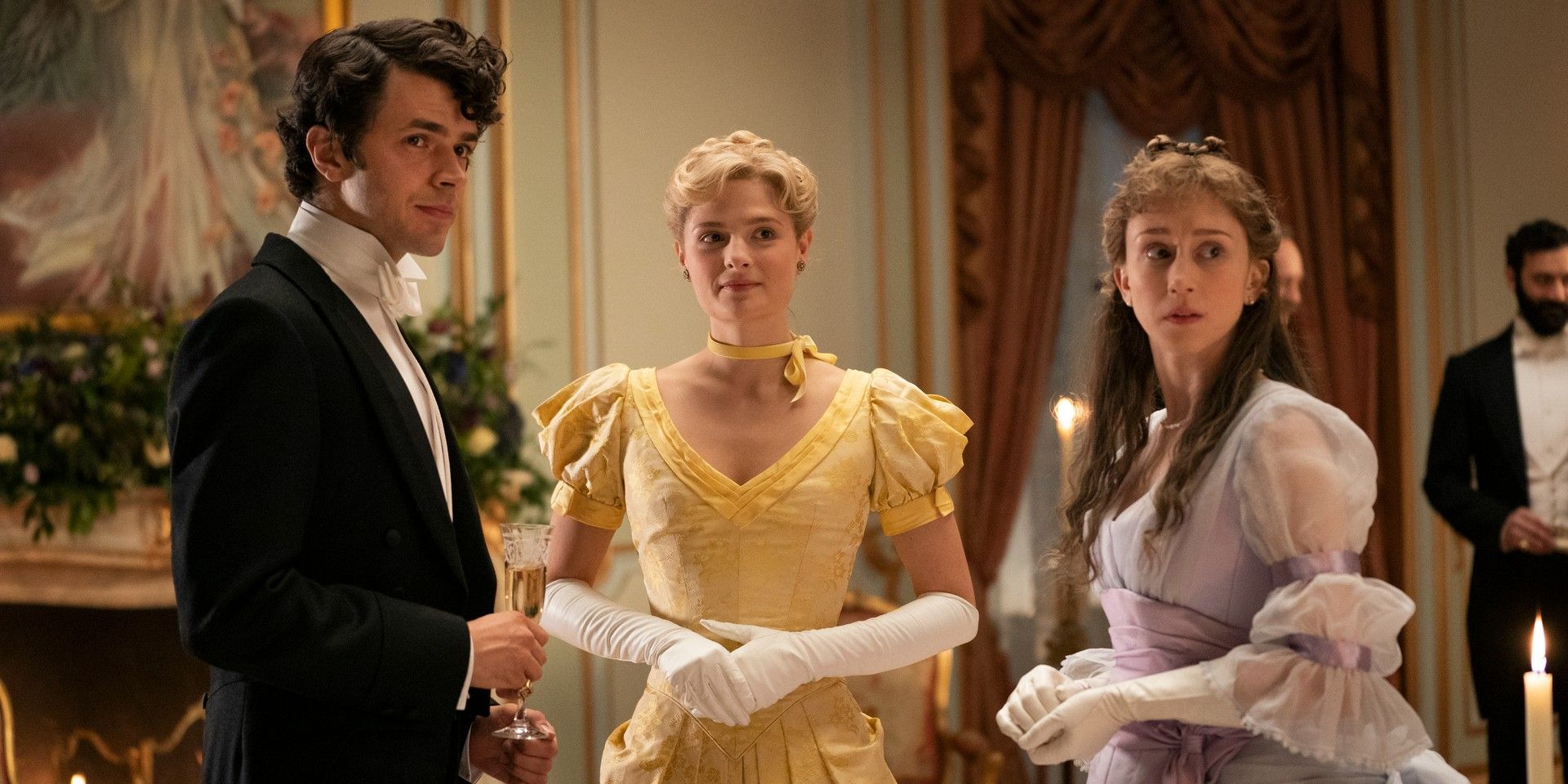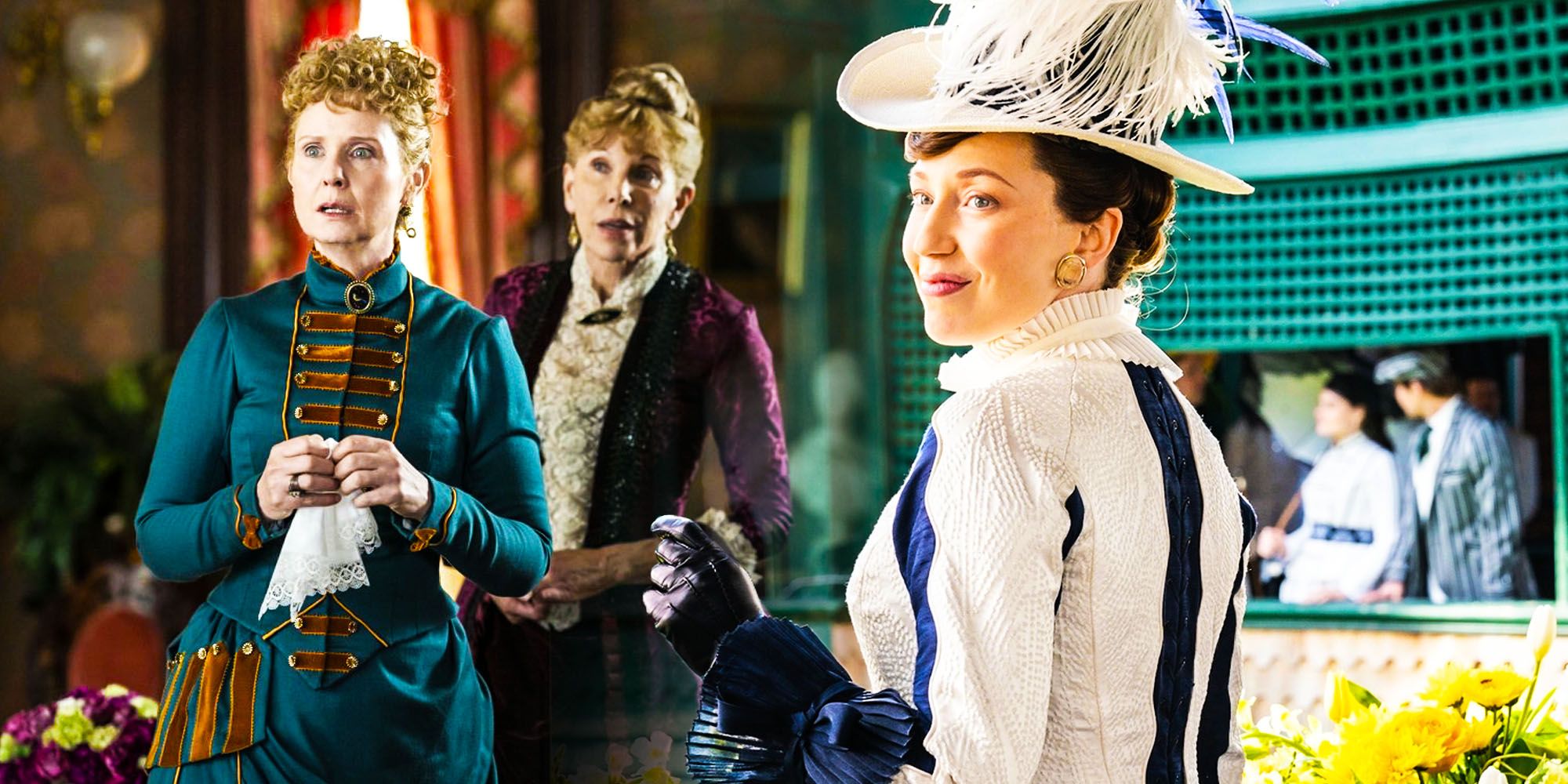HBO’s series The Gilded Age takes a close look at the families of New York’s High Society in the late 1800s, in particular, the Russells of New York. Much like other popular, scandal-filled period dramas like Bridgerton or Downton Abbey, The Gilded Age takes a fictionalized look at the lives and happenings of the rich, prominent families of New York, combining fact and fiction. The series was created by English actor and screenwriter Julian Fellowes, who also created Downton Abbey. Fellowes began developing The Gilded Age, which he described as an “American Downton,” for NBC in 2016 before the series eventually landed on HBO in 2019.
While the two families at the center of The Gilded Age, the Van Rhijn/Brook family, and the Russell family, are not real Gilded Age New York families, they reflect the real class distinctions made between the old-money families and new-money families during that time. The Van Rhijn/Brook family is an old-money family headed by a widowed matriarch named Agnes Van Rhijn (Christine Baranski), a stubborn New York City socialite who strictly adheres to the values of New York Society (and is the perfect replacement for Maggie Smith’s Dowager Countess). She and her spinster sister, Ada Brook (Cynthia Nixon), take in their niece Marian Brook (Louisa Jacobson) after the death of Marian’s father, their estranged brother. Agnes is scandalized when the Russells, a new-money family, move into a new, lavish mansion across the street from their home. Bertha Russell (Carrie Coon), the wife of robber-baron George Russell (Morgan Spector), is determined to make her mark on high society in New York, but quickly learns that the old-money wives don’t accept her into their exclusive inner circle.
The Gilded Age takes a fictionalized look at the lives of wealthy Americans in the 19th century, but the series is based on the real New York families at the center of the real historical Gilded Age, a prominent time of rapid economic growth in the United States. The Russells of New York are fictional but are inspired by the real-life Vanderbilts, who at one point were the wealthiest family in the United States. Many of the other families portrayed in the series are real prominent New York families, and some well-known Gilded Age socialites actually appear as characters in the series. Here is a look at the real history of New York’s social elite, and how the Vanderbilt family inspired The Gilded Age.
The Gilded Age’s New York Families: Which Are Real?

The Russells of New York are not a real family, but Carrie Coon’s character Mrs. Russell name-drops some prominent historical New York families that she would like to invite to her lavish party. Aside from the Van Rhijn family, the names she mentioned are real old-money families that were prominent during the Gilded Age. Mamie Fish, Caroline and Carrie Astor, the Livingstons, the Roosevelts, and the Vanderbilts were all real people. The Gilded Age‘s Astor family, especially Caroline, was one of the most important families of the real Gilded Age, being an old-money family and a prominent part of New York high society. Their name has influenced various well-known parts of New York, including the Astoria neighborhood in Queens. Caroline Astor had the most influence in determining who was who in New York, establishing the Four Hundred, a list of prominent people whom she considered the best of high society. Her daughter, Carrie, was also a New York City socialite and shook up the Four Hundred when she urged her mother to invite Alva Vanderbilt to her parties so she could attend the Vanderbilts’.
Alva Vanderbilt and Mamie Fish were part of the Four Hundred, along with Tessie Oelrichs. Mamie Fish wanted to be seen as the “fun maker” and was known to throw outrageous parties. In the series, the Russells’ son Larry (Harry Richardson) meets Carrie Astor (Amy Forsyth) at one of her parties, whom his mother wants him to know because of her family name. Alva Vanderbilt does not appear in the series but is mentioned as an example of a new money family being accepted by the old money high society. Alva helped establish the Vanderbilt family socially among the old families, who previously looked down on the Vanderbilts because of their patriarch’s reputation as a robber baron.
The Livingston family, mentioned as the family that Agnes Van Rhijn and her family are descended from, is a prominent New York family who traces their ancestry back to the 4th Lord Livingston. The Astor family and the Fish family are also both alleged descendants of the Livingston line. Ward McAllister, portrayed in The Gilded Age cast by Nathan Lane, was a tastemaker and a cousin of the Astor family whose patroness was Caroline Astor. He coined the term “The Four Hundred” and touted himself as an expert on the New York gentry. McAllister published a book called Society As I Have Found It in 1890, which ruined his social reputation with the high society families, who valued their privacy and saw the book as a violation.
The Real-Life Vanderbilt Family Explained

The Gilded Age centers around the Russells as they attempt to become a part of New York’s high society. In real life, the Vanderbilt family had a similar trajectory. The Gilded Age‘s Vanderbilt family was considered a new-money family because, unlike the old money families, the Vanderbilts were not prominent before the American Revolution. Cornelius Vanderbilt was the patriarch who amassed a large fortune in the shipping and railroad industries in the mid-1800s. He was referred to as a “robber baron,” which is a derogatory term for a businessman who uses exploitative practices to build their wealth. Cornelius is the original American “robber baron,” as the term was first used to describe his business practices by the New York Times in 1859. He was considered rough and uncultured by the upper-class New Yorkers, though he was quickly becoming the richest man in the city.
The members of the Vanderbilt family mentioned in The Gilded Age‘s timeline are Cornelius’s grandson William Kissam Vanderbilt and his first wife Alva Vanderbilt. William ran the family’s railroad investments after his grandfather’s death and inherited $55 million of the Vanderbilt fortune. His then-wife, Alva, wanted to be a part of high society and was a social climber. She not only succeeded in helping the Vanderbilt family become acceptable in the eyes of the old money families of New York but even challenged the reign of Caroline Astor, whose parties decided who was a part of the Gilded Age Four Hundred. William and Alva had three children before William’s infidelity eventually ended their marriage. Alva later went on to marry US Representative Oliver Belmont.
How The Vanderbilts Factor Into The Gilded Age Show

The Vanderbilts are figures who, in the series, serve as Bertha Russell’s inspiration for a new-money family becoming accepted by society. They also serve as the real-life Gilded Age family that the Russells are modeled after. The Russells are a new-money family who gained their fortune because of George Russell’s amassed wealth from the railroad industry. Mr. Russell more closely parallels Cornelius Vanderbilt than William Kissam Vanderbilt, who was actually a prominent Gilded Age figure. George, like Cornelius Vanderbilt, is himself a robber baron who is making his fortune by buying railroads and building new railroads to out-compete other businessmen who won’t sell to him. His wife Bertha, however, takes inspiration from William Kissam Vanderbilt’s wife Alva, who was determined to be accepted by New York’s high society and eventually became so prominent in society that she could essentially determine who was part of the coveted Four Hundred.
In The Gilded Age season 1, Mrs. Russell mentions the Vanderbilts when she talks about her ambition to make her mark on the upper echelon of New York society. The “Mrs. Vanderbilt” she refers to in the first episode is Alva, who is credited with helping the Vanderbilts become accepted by high society New York. The old-money families of New York shun Mrs. Russell in the first episode of The Gilded Age, which makes her determined to make her mark on society. Like Mrs. Vanderbilt, she becomes a skilled social climber, calculating her way into the coveted Four Hundred. The Russells’ daughter, Gladys (Taissa Farmiga), is also likely modeled after William Vanderbilt and Alva Belmont’s daughter Consuelo, who Alva had married off to the Duke of Marlborough to secure their place in high society. The former Duchess’s arranged marriage could hint toward a possible future for The Gilded Age‘s Gladys, who lives by the rules of her opportunistic mother.
What Will Happen To The Russell Family In The Gilded Age Season 2?

With The Gilded Age renewed for season 2, the Russells of New York will have even more social climbing to do and high-society scandals to deal with. Season 1 ended with several story threads resolved and several more left dangling. George Russell’s legal trouble after the suspicious train crash his company suffered was wrapped up by The Gilded Age season 1 finale, which also saw the Russells throw a debutante ball for Gladys that was filled with plenty of drama. Most likely, now that the Russells have the social toe-hold they’ve been fighting for, The Gilded Age season 2 will see them fight to keep their place among New York’s high-society elite and face continued scrutiny from their old-money counterparts. The real-life Vanderbilt family experienced plenty of ups and downs on their path to fame, fortune, and social standing, so presumably, the fictional Russells will face a similar trajectory to their true story inspiration in the next season of The Gilded Age.




